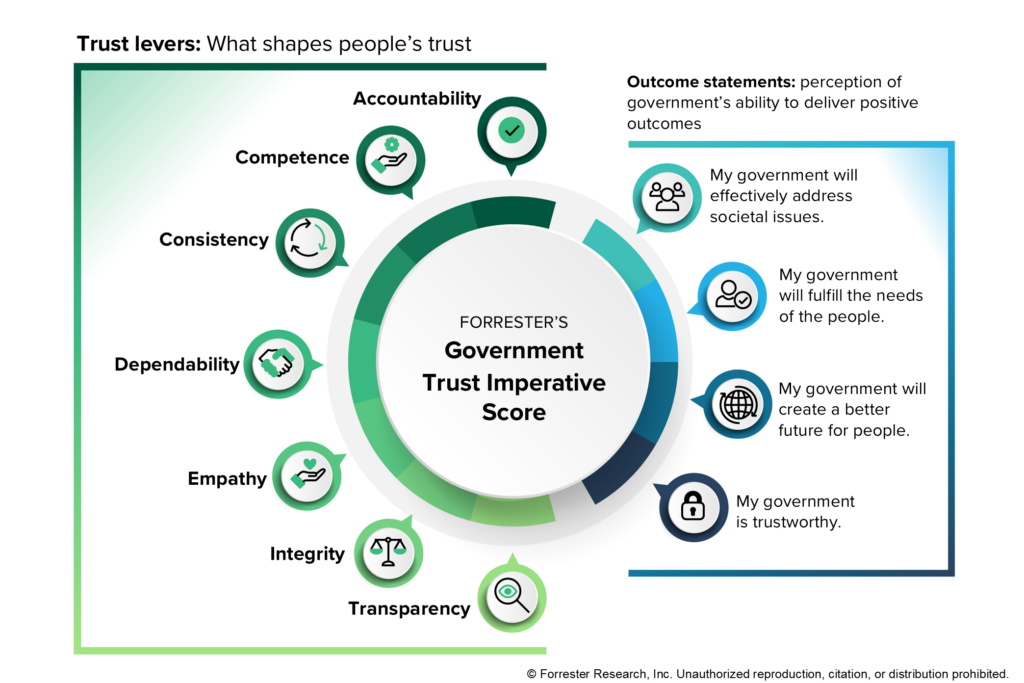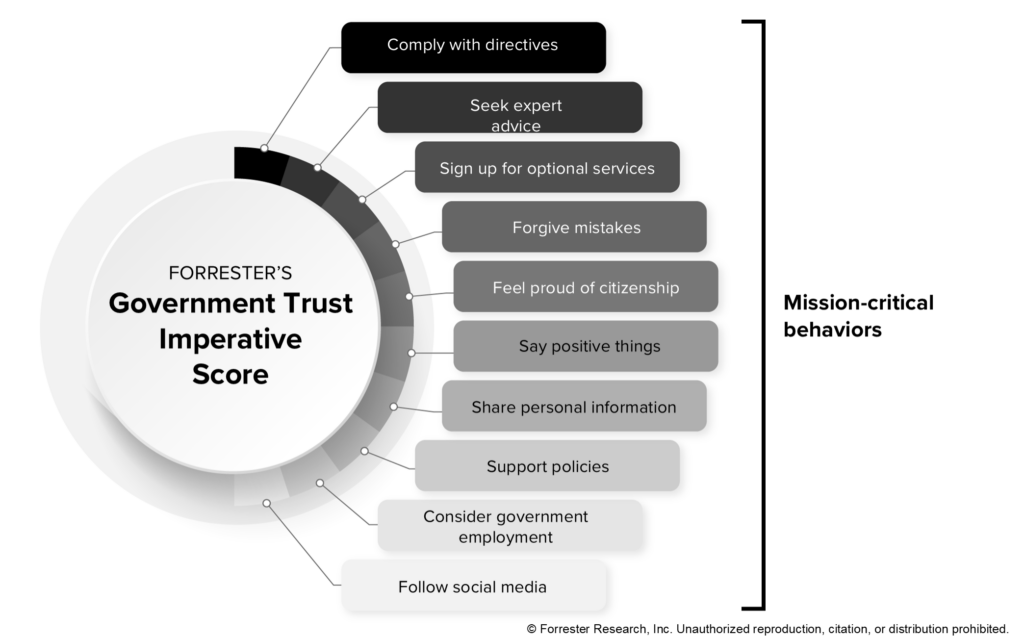Introducing Forrester’s New Government Trust Imperative Score
Trust Is Both Cognitive And Emotional
Trust is the measure of confidence someone has that a person or organization will spark a specific positive outcome in a relationship. It manifests in many ways – we can think of trust in terms of spiritual or religious beliefs, fidelity in relationships, and of course physical safety. Take handshaking, a common act that many cultures today use as form of greeting: It originated as a way for people to demonstrate they weren’t armed, fostering trust between strangers.
Trust therefore is both cognitive and emotional: It involves reasoning, judgment, and evaluation, and it’s closely tied to how we feel about a person, place, institution, or organization.
Trust Is Essential For Government To Function
The institution of government is at its very core a demonstration of trust — between the people, their elected representatives, and the institutions created to serve them. When trust is strong, government organizations reap social, economic, and reputational benefits enabling them to achieve mission success. When it’s weak, they must work harder to sustain effective services, economic well-being, and social cohesion. Improving public trust is the second highest mission-driven priority for public sector and government decision makers globally (54%), according to Forrester’s Priorities Survey, 2025. Trust results from the accumulation of a broad range of experiences over time, so it’s hard to earn but easy to lose — trust can be damaged by a single event.
Perhaps surprisingly, this is true not only for liberal democracies, but for other political systems as well. For example, the 2022 “White Paper Protests” in China showed how falling public trust in government led to a dramatic policy shift, even in a tightly controlled authoritarian regime.
We Can Measure How Governments Earn People’s Trust
While many government leaders understand the importance of trust, they often misunderstand what it is, what drives it, and what results from having earned it. Even fewer governments formally measure trust and link it to their mission outcomes, relying instead on popularity polls based on personality rather than substantive policy.
That’s why Forrester developed the Government Trust Imperative Score (GTIS) to measure trust at three levels of government — national/federal, provincial/state, and local/municipal — as well as for supranational bodies like the EU. This score is the “trust grade” that a government as a whole — including its branches, agencies, elected officials, and public servants — earns from the people it serves.
To calculate the GTIS, our algorithm uses seven universal levers of trust and four outcome statements.

Use GTIS To Drive Mission-Critical Behaviors
Many of our public sector and government clients have seen our efforts first hand with the publication of our pilot in 2022. Unlike other trust-related methodologies, Forrester’s GTIS assesses what creates trust in government and how that trust drives mission-critical behaviors among the public. GTIS proves that stronger trust:
-
-
- Drives compliance and willingness to share personal information. People who trust the institution of government were much more likely to say they will comply with advice and directives and share personal information with government organizations. The gap between people with strong or very strong trust and people with weak or very weak trust who say that they are likely to comply with government directives is 30 percentage points in Australia, 33 percentage points in the UK, and 38 percentage points in the US.
-
-
-
- Gives the government permission to deliver more services. People who trust government are more likely to proactively seek government expertise and sign up for existing optional services and are more eager for government to innovate and offer new services.
-
-
-
- Increases tolerance for mistakes and earns forgiveness. This tolerance increases people’s willingness to continue to engage with government despite its imperfections. There’s a stark difference in people’s readiness to forgive the government for potential future mistakes based on their current level of trust in it.
-

Focusing on two dimensions important to almost every government organization — willingness to share personal information with the government and willingness to comply with a directive from the government — results in a framework with four distinct behavioral segments (Supporters, Minimalists, Cynics, and Beneficiaries). For each segment, we identified trust levers that governments must consider for policy development, program design, and service delivery to evoke the highest level of trust.
For details about our trust model for government, read our report Introducing Forrester’s Government Trust Imperative Score. Forrester clients can also schedule a guidance session with me or my colleagues who contributed to this research.
Stay tuned for GTIS data overview reports for Australia, Singapore, the UK, and the US!
This blog was created with the assistance of Senior Research Associate, Chiara Bragato.
